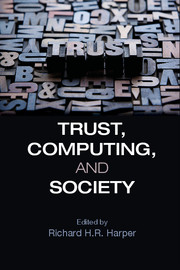Refine search
Actions for selected content:
48276 results in Computer Science

Trust, Computing, and Society
-
- Published online:
- 05 March 2014
- Print publication:
- 28 February 2014
NAIVE TRUTH AND NAIVE LOGICAL PROPERTIES
-
- Journal:
- The Review of Symbolic Logic / Volume 7 / Issue 2 / June 2014
- Published online by Cambridge University Press:
- 04 March 2014, pp. 351-384
- Print publication:
- June 2014
-
- Article
- Export citation
TLP volume 14 issue 2 Cover and Front matter
-
- Journal:
- Theory and Practice of Logic Programming / Volume 14 / Issue 2 / March 2014
- Published online by Cambridge University Press:
- 04 March 2014, pp. f1-f2
-
- Article
-
- You have access
- Export citation
TLP volume 14 issue 2 Cover and Back matter
-
- Journal:
- Theory and Practice of Logic Programming / Volume 14 / Issue 2 / March 2014
- Published online by Cambridge University Press:
- 04 March 2014, pp. b1-b2
-
- Article
-
- You have access
- Export citation
Programming with Higher-Order Logic, by Dale Millerand Gopalan Nadathur , Cambridge University Press, 2012, Hardcover, ISBN-10:052187940X, xiv + 306 pp.
-
- Journal:
- Theory and Practice of Logic Programming / Volume 14 / Issue 2 / March 2014
- Published online by Cambridge University Press:
- 04 March 2014, pp. 265-267
-
- Article
- Export citation
Microwave building as an application of wireless power transfer
-
- Journal:
- Wireless Power Transfer / Volume 1 / Issue 1 / March 2014
- Published online by Cambridge University Press:
- 21 March 2014, pp. 1-9
- Print publication:
- March 2014
-
- Article
-
- You have access
- HTML
- Export citation
Spiral resonators for optimally efficient strongly coupled magnetic resonant systems
-
- Journal:
- Wireless Power Transfer / Volume 1 / Issue 1 / March 2014
- Published online by Cambridge University Press:
- 21 March 2014, pp. 21-26
- Print publication:
- March 2014
-
- Article
- Export citation
State-of-the-art of contactless energy transfer (CET) systems: design rules and applications
-
- Journal:
- Wireless Power Transfer / Volume 1 / Issue 1 / March 2014
- Published online by Cambridge University Press:
- 21 March 2014, pp. 10-20
- Print publication:
- March 2014
-
- Article
-
- You have access
- HTML
- Export citation
